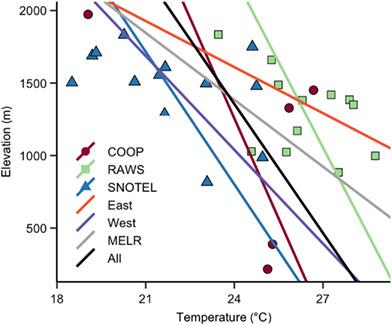当前位置:
X-MOL 学术
›
Int. J. Climatol.
›
论文详情
Our official English website, www.x-mol.net, welcomes your feedback! (Note: you will need to create a separate account there.)
Best practices for estimating near‐surface air temperature lapse rates
International Journal of Climatology ( IF 3.9 ) Pub Date : 2020-05-18 , DOI: 10.1002/joc.6668 A. C. Lute 1 , John T. Abatzoglou 2, 3
International Journal of Climatology ( IF 3.9 ) Pub Date : 2020-05-18 , DOI: 10.1002/joc.6668 A. C. Lute 1 , John T. Abatzoglou 2, 3
Affiliation

|
The near‐surface air temperature lapse rate is the predominant source of spatial temperature variability in mountains and controls snowfall and snowmelt regimes, glacier mass balance, and species distributions. Lapse rates are often estimated from observational data, however there is little guidance on best practices for estimating lapse rates. We use observational and synthetic datasets to evaluate the error and uncertainty in lapse rate estimates stemming from sample size, dataset noise, covariate collinearity, domain selection, and estimation methods. We find that lapse rates estimated from small sample sizes (<5) or datasets with high noise or collinearity can have errors of several °C km−1. Uncertainty in lapse rates due to non‐elevation related large‐scale temperature variability was reduced by correcting for spatial temperature gradients and restricting domains based on spatial clusters of stations. We generally found simple linear regression to be more robust than multiple linear regression for lapse rate estimation. Finally, lapse rates had lower error and uncertainty when estimated from a sample of topoclimatically self‐similar stations. Motivated by these results, we outline a set of best practices for lapse rate estimation that include using quality controlled temperature observations from as many locations as possible within the study domain, accounting for and minimizing non‐elevational sources of climatic gradients, and calculating lapse rates using simple linear regression across topoclimatically self‐similar samples of stations which are roughly 80% of the station population size.
中文翻译:

估算近地表气温下降速率的最佳实践
近地表气温下降速率是山区空间温度变化的主要来源,它控制着降雪和融雪状态,冰川质量平衡和物种分布。流失率通常是从观察数据中估算的,但是,关于估算失效率的最佳实践的指导却很少。我们使用观察性和综合性数据集来评估失误率估计中的误差和不确定性,这些失误和估计源于样本量,数据集噪声,协变量共线性,域选择和估计方法。我们发现从小样本量(<5)或具有高噪声或共线性的数据集估计的失误率可能会有几度°C km -1。通过校正空间温度梯度并基于站点的空间簇来限制域,可以减少由于非海拔相关的大规模温度变化而导致的失误率的不确定性。我们通常发现简单线性回归比失误率估计的多重线性回归更健壮。最后,从地形自相似站的样本进行估算时,流失率具有较低的误差和不确定性。根据这些结果,我们概述了一组失误率估算的最佳做法,包括在研究范围内尽可能多的位置使用质量受控的温度观测值,并考虑和最小化非梯度气候梯度源,
更新日期:2020-05-18
中文翻译:

估算近地表气温下降速率的最佳实践
近地表气温下降速率是山区空间温度变化的主要来源,它控制着降雪和融雪状态,冰川质量平衡和物种分布。流失率通常是从观察数据中估算的,但是,关于估算失效率的最佳实践的指导却很少。我们使用观察性和综合性数据集来评估失误率估计中的误差和不确定性,这些失误和估计源于样本量,数据集噪声,协变量共线性,域选择和估计方法。我们发现从小样本量(<5)或具有高噪声或共线性的数据集估计的失误率可能会有几度°C km -1。通过校正空间温度梯度并基于站点的空间簇来限制域,可以减少由于非海拔相关的大规模温度变化而导致的失误率的不确定性。我们通常发现简单线性回归比失误率估计的多重线性回归更健壮。最后,从地形自相似站的样本进行估算时,流失率具有较低的误差和不确定性。根据这些结果,我们概述了一组失误率估算的最佳做法,包括在研究范围内尽可能多的位置使用质量受控的温度观测值,并考虑和最小化非梯度气候梯度源,



























 京公网安备 11010802027423号
京公网安备 11010802027423号